Commercial Salmon Fisheries
Southeast Alaska & Yakutat Research: Port Sampling

Figure 1. — Click for more Info
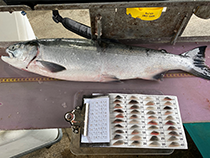
Figure 2. — Click for more Info
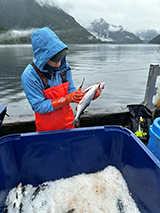
Figure 3. — Click for more Info
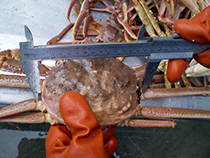
Figure 4. — Click for more Info

Figure 5. — Click for more Info
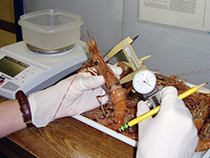
Figure 6. — Click for more Info
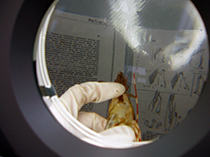
Figure 7. — Click for more Info
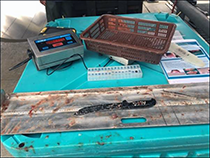
Figure 8. — Click for more Info
Introduction
The Alaska Department of Fish and Game (ADF&G) operates a commercial fisheries port sampling program in Southeast Alaska to gather biological and catch-per-unit-effort data from the harvest of salmon, shellfish, and groundfish in the Region I Management Areas. This program employs up to five fishery biologists (Port Supervisors) and upwards of 30 Fish and Wildlife Technicians to supervise and conduct sampling activities at six ports: Juneau, Sitka, Petersburg, Wrangell, Ketchikan, and Craig. Occasionally, biologists and technicians also conduct sampling on tenders or at buying stations. Buying stations can include Elfin Cove, Port Alexander/Port Armstrong, and Pelican. Currently, ADF&G area management staff collect samples in Haines and Yakutat.
Commercial port sampling program staff work closely with fishery managers, research biologists, fish processing staff, and permit holders to collect data. Port samplers collect information from a variety of different commercially important species including all five species of Pacific salmon, sablefish (black cod), Dungeness crab, king and tanner crab, shrimp, and geoduck clams. The port sampling program has established sampling objectives that rarely change year to year. In addition to these objectives, the program will collect data to fulfill short term special project needs. For some species data are collected using an electronic application on a tablet that is uploaded to the state database making it accessible to managers and researchers often within 24 hours of collection (Figure 1).
Pacific Salmon
Salmon data collected through the Port Sampling Program is used to manage fisheries, analyze stock composition and contributions, create brood tables, generate run forecasts, determine migratory patterns and routes, determine size-at-age relationships, and fulfill international harvest sharing agreements outlined in the Pacific Salmon Treaty (PDF).
When sampling salmon, port samplers collect a variety of data dependent on fishing period, gear, harvest type, and species. Scales are collected for age determination, fish length measurements for size at age, otoliths for hatchery mark recovery, and fin clips for genetic stock identification (Figure 2). Port Samplers also determine the possible presence of a coded wire tag (CWT) in coho and Chinook salmon. Fishery performance data are collected from troll permit holders to estimate catch-per-unit-effort , and pink salmon sex ratios are collected from purse seine landings for use in harvest forecasting and to determine run timing (Figure 3).
Crab
Port samplers collect data from landings of Dungeness crab, Tanner Crab and three species of king crab; golden, red, and blue. When sampling crab in Southeast Alaska, port samplers take a measurement of the crab carapace, determine shell condition and hardness and check for damage to the carapace and legs, and conduct a confidential interview (Figure 4). In the Dungeness crab fishery, specific questions about percentage of sublegal males and/or females in the catch, percentage of females with eggs, and soak time are also asked. When sampling king crab, the permit holder is asked if they harvested any crab with the parasitic barnacle, Briarosaccus callosus, and note any found in their sample. In addition to regular crab sampling duties individual weights are collected from golden and blue king crab.
There is no directed fishery for blue king crab in Southeast Alaska and they are only retained as incidental harvest in the golden king crab, red king crab, and Tanner crab fisheries, making dockside data especially important. Port samplers examine any blue king crab they encounter and collect carapace width in addition to the standard length.
Geoduck Clams
Each season port sampling and management staff collect weights from 100 geoduck clams per open area from at least four divers (Figure 5). A maximum of 25 clams per diver can be collected. Dockside geoduck weight data is used to expand the abundance of geoducks determined during dive surveys into biomass to get the guideline harvest levels.
Shrimp
Samples of shrimp are collected by ADF&G management staff on department sponsored stock assessment surveys and by port sampling staff from permit holders and seafood processors. The objectives of shrimp sampling are to gather data and information on size frequency, sex, the presence or absence of eggs and parasites, fishing location, effort levels, and estimates of average catch per unit of effort (Figure 6). Port sampling staff located in Petersburg analyze these samples for use in size-at-sex determination (Figure 7).
Sablefish
Port samplers assist groundfish management staff with sampling sablefish in ports where no groundfish staff are located. From each sablefish sampled, port samplers collect a length, weight, sex, maturity, and otoliths for age determination (Figure 8).
Selected Publications
- Southeast Alaska commercial salmon port sampling 2020. (PDF)
- Operational Plan: Southeast Alaska and Yakutat salmon commercial port sampling 2020 (PDF)
- Southeast Alaska shellfish port sampling, 2022 (PDF)
- Summary of crab dockside sampling in Southeast Alaska during the 2019/2020 commercial fishing season. (PDF)
- Summary of dockside port sampling in Southeast Alaska during the 2016/2017-2017/2018 commercial shrimp pot and beam trawl fishing seasons. (PDF)
